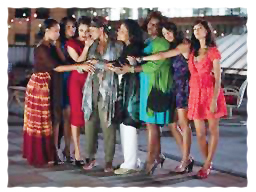
For Colored Girls

The ladies of ‘For Colored Girls’in in a group embrace in the final scene of the film where they came together and made the decision to be there for one another.
The show opens with Tangie throwing her latest lover out of her house. Right after that, as Juanita arrives to irritate Frank with a house plant, Kelly, who works for child welfare, attempts to visit Crystal on behalf of the children, does not get very far. Meanwhile, Alice shows up to beseech Tangie for money, but gets rebuffed instead. Alice goes out to raise money, and encounters Yasmine, who gives her a little money.
Sounds like spaghetti, and in a sense it is, but the director manages to unfold the plot coherently through these multiple character lines.
Yasmine, a dance teacher, is boasting aboat how dancing affords her underprivileged girls a way out of the ghetto, and into college. Nyla tells her friends in the class about her graduation night with a pack of cousins, then has to throw up. Kelly’s husband comes over and arrests two men, one of whom is Jo’s husband.
For Colored Girls was shown at the Franco Nambia Cultural Centre on Wednesday this week as film maker Matilde Kulo’s film of choice.
The film is based on South African Ntozake Shange’s play titled ‘For Colored Girls Who Have Considered Suicide When the Rainbow is Enough’ and was transformed into an expanded film by film writer and director, Tyler Perry who made the stage experience a flowing enigmatic story.
Each of the women portrays one of the characters represented in the collection of twenty poems, revealing different issues that impact women in general and women of colour in particular. They all deal with personal conflicts, abandonment, rape, infidelity, love and abortion.
The characters are all portrayed by colour. Jo who is played by singer and actress Janet Jackson is portrayed by the colour red. Juanita played by Loretta Devine is green. Yasmine who is played by Anika Noni Rose is portrayed by the colour yellow. Tangie who is played by Zimbabwean actress Thandie Newton, is purple. Alice is played by Whoopi Goldberg and is portrayed by the colour white. Gilda played by actress Phylicia Rashad who is well known for her role in the 80’s family comedy, the Cosby’s Show is portrayed by the colour grey. Actress Kimberly Elise who plays Crystal, an abused mother of two whose children are later killed by their father, is also grey.
Kerry Washington plays the part of Kelly and is blue and Tessa Thompson plays a purple Nyla.
The film shows the women in vulnerable situations where Yasmine is raped by a friend whom she trusted, Loretta Devine is abandoned by her boyfriend Frank, Crystal’s children are dropped from a 5-storey apartment by her boyfriend, while Jo discovers that her husband has infected her with HIV and has been sleeping with men.
Watching this film made me realise that we all have to sometimes reflect on our lives and find out who we really are and must be strong enough to help one another deal with issues pertaining to life. The film does have a bad portrayal of men but ends in a good way with the women coming together and offering support to one another. It ends with the line and this is for colored girls who have considered suicide but are moving towards the end of their rainbows’.
Twice every month the FNCC shows films that are chosen by Namibian film makers.










































